Why look at the best weightlifting shoes for 2022?
Lifting heavy weights requires the proper footwear. Many people lift using normal sneakers or running shoes – and that is a big mistake.
They should be using proper weightlifting shoes, like the Nike Romaleos 4 shown here instead.

We’ll review who makes the best weightlifting shoes for 2022, and tell you why they are the best.
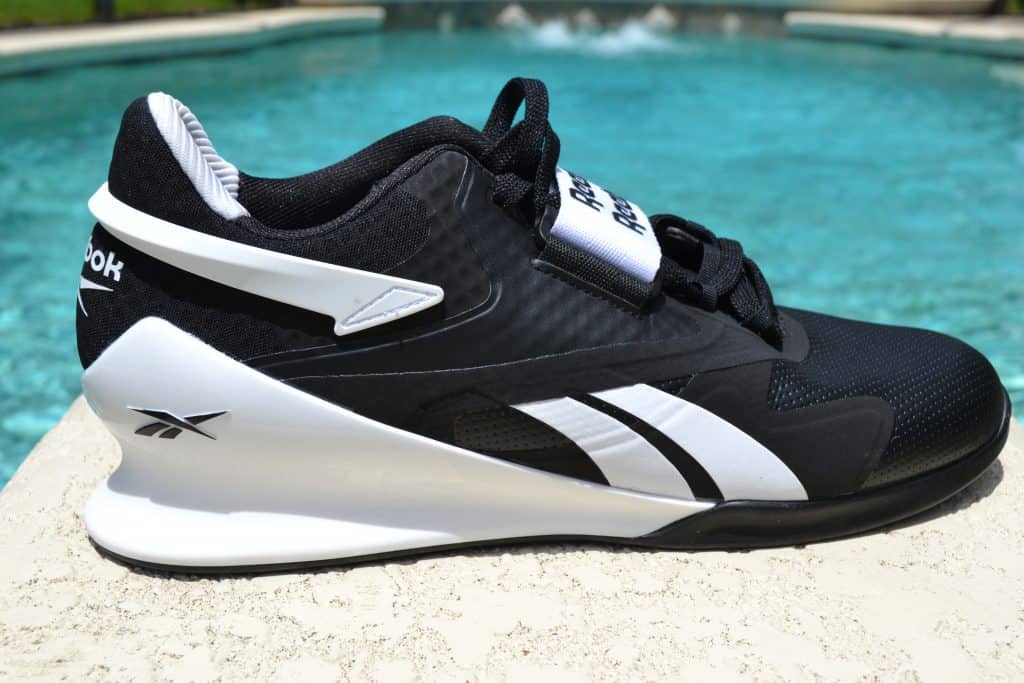
These are the best shoes for Olympic weightlifting, powerlifting, and the Oly lifting portions of the CrossFit WOD.
Here are the shoes we are going to review in this article.
Let’s talk about what makes these shoes the best for Olympic weightlifting, and squatting in particular.
Why You Need Proper Weightlifting Shoes
Why aren’t regular sneakers or running shoes good for lifting weights?
It’s simple – running shoes have way too much padding and cushion.
This makes them great for the repeated, jarring shocks and impact of running.
But, it doesn’t make them very good for hoisting hundreds of pounds above your head or on your back.
Running shoes have many desirable qualities – they are light, comfortable, breath well, and normally provide lots of traction.
Their fundamental weakness is having too much cushion in the midsole and outsole.
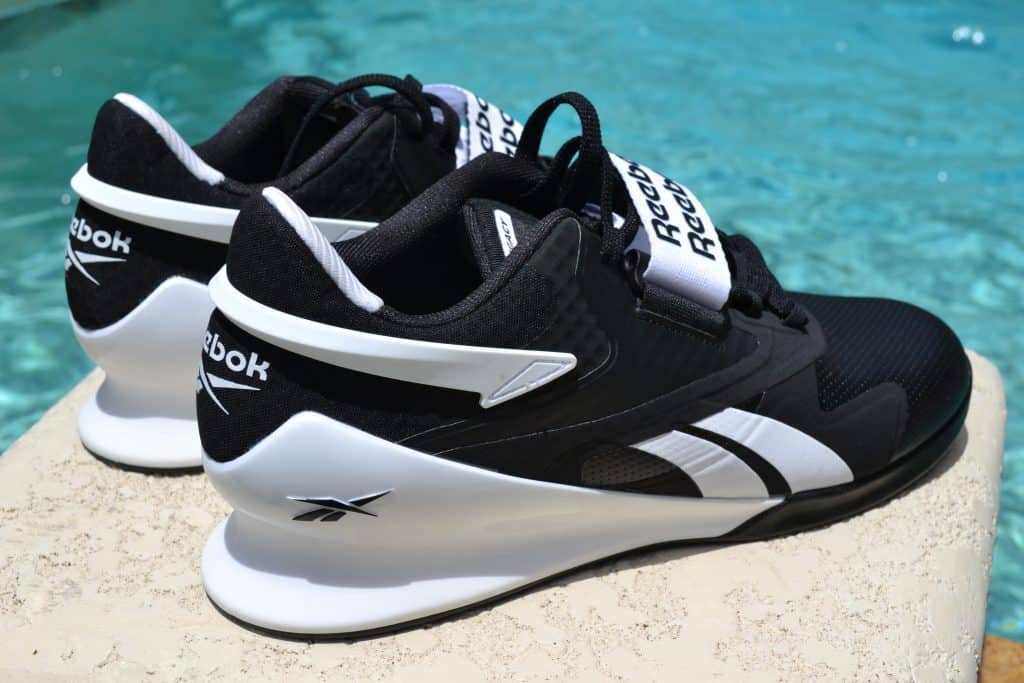
And most of them don’t have enough of a heel raise to really work well for lifting weights either.
Take a look at the Reebok Legacy Lifter II weightlifting shoe above. See that sky-high heel? That helps – a lot.
What you can’t see is that it’s also rigid – and won’t deform under dozens (or hundreds) of pounds.
Lifting without weightlifting shoes?
You could be sacrificing a PR (personal record) or even worse – risking an injury.
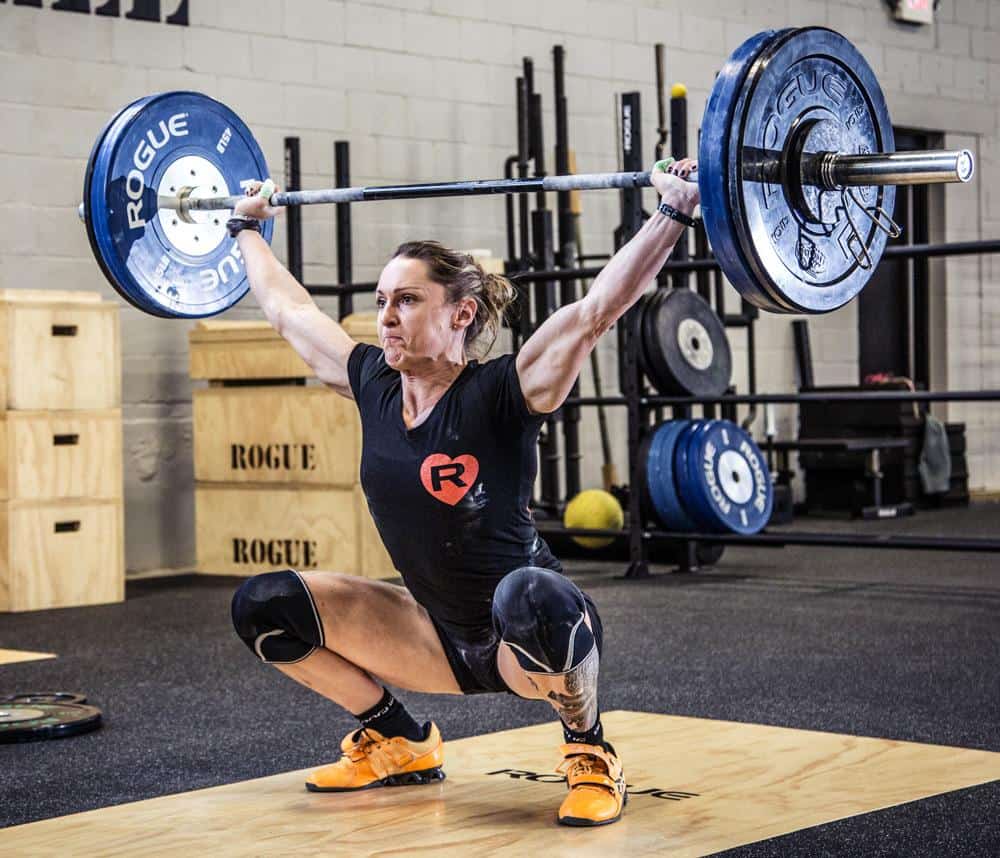
We need something that is the opposite of a running shoe.
It should offer stable and rigid support, with a lot of heel raise, and it doesn’t matter how heavy it is – we’ll be standing in one place.
Let’s talk about why you need those things.
Features of the Best Weightlifting Shoes (Squat Shoes or “Lifters”)
Purpose-built weightlifting shoes are specialized for lifting weights.
And whether you are looking for men’s or women’s weightlifting shoes – all the best weightlifting shoes will have these things in common.
Weightlifting Shoes Have a Rigid Sole and Heel
What is the most important feature of weightlifting shoes (also called squat shoes or “lifters”)?
The primary benefit is that weightlifting shoes have a firm sole and solid heel.
How solid? The heel is sometimes even made of solid wood – or another equally rigid material.
They are stable – really stable. Your foot will not sink into any of the foam cushioning like that typically used in running shoes.
That’s a big deal because it’s easier on your joints and helps prevent injury.
And it also helps to ensure efficient power transfer.
The Olympic lifts (the clean and jerk, and snatch) are done fast and it’s the power generated by the lifter that enables them to lift the weight.
Let’s not waste that power by compressing a jelly-like midsole – let’s use it to get the weight overhead instead.
But these shoes aren’t just for Olympic lifters.
The “slow” lifts of powerlifting (the squat, and deadlift) can benefit as well.
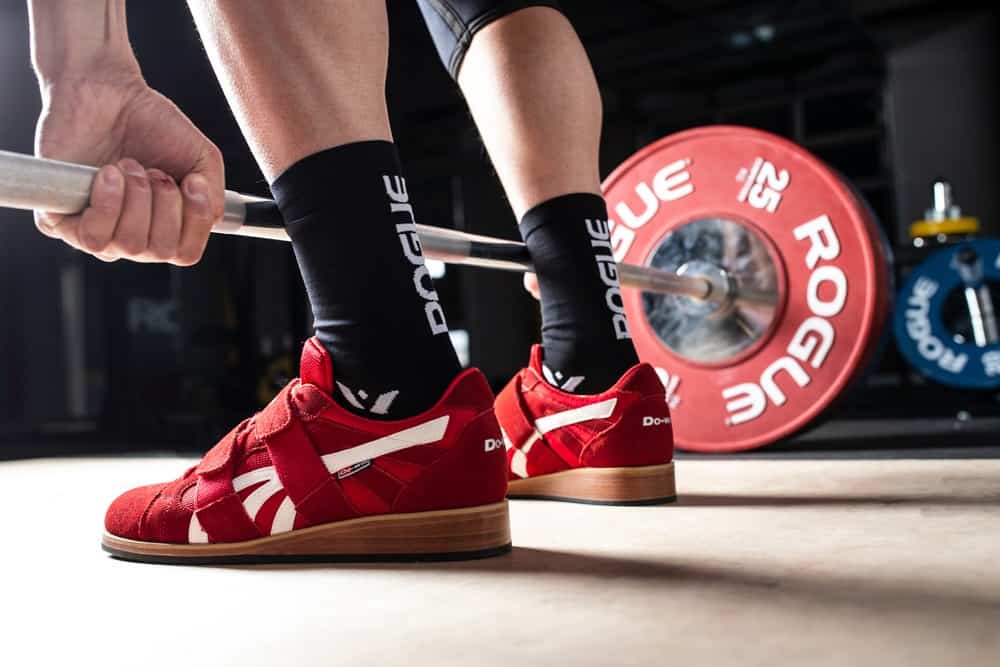
In any case, the last thing you want with a heavily loaded barbell on your back (or in your hands) is to have your foot smooshing around in a rubbery soled shoe.
The angles of compression in your knee joint shouldn’t be constantly changing as you move the weight.
There are trade-offs to having this rigid sole and heel – typically weightlifting shoes are much heavier than regular sneakers or running shoes.
But, that’s OK – we are not running, jumping, or sprinting in these shoes.
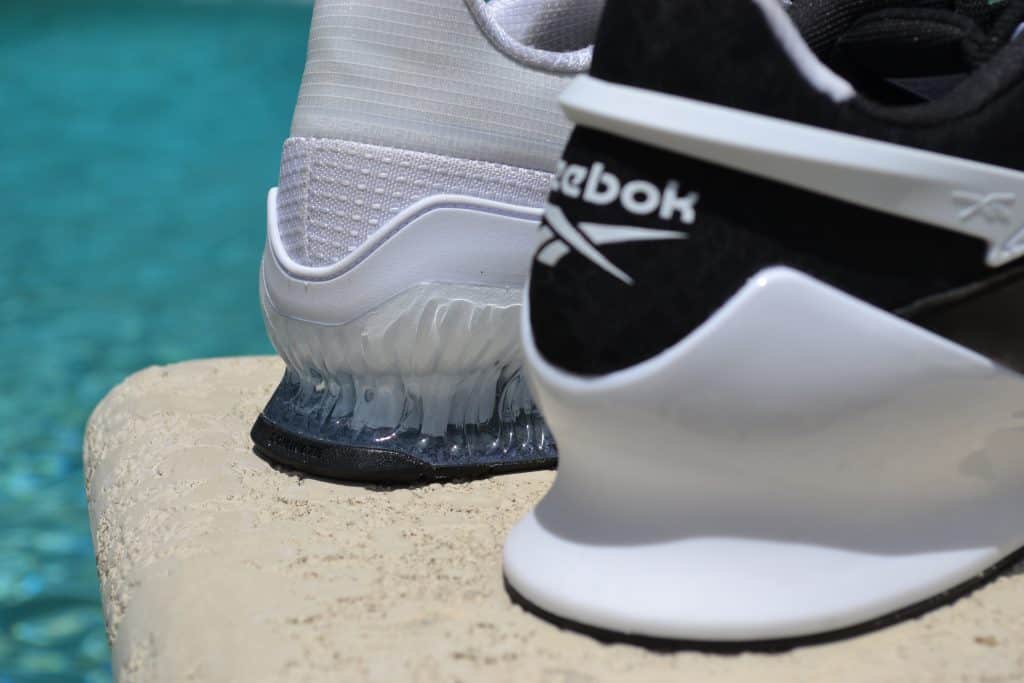
Weightlifting Shoes Have a Raised Heel
Weightlifting shoes also typically have a raised heel.
Here’s the heel of Nike’s and Reebok’s best weightlifting shose – the Nike Romaleos 4 and Legacy Lifter II.
See how tall the heel is?
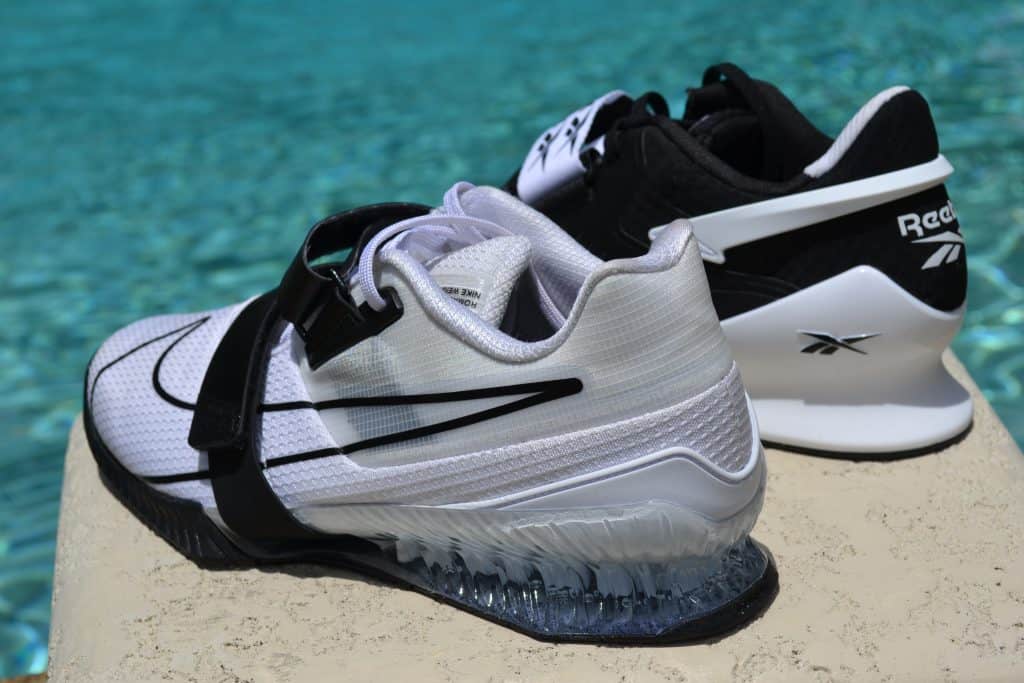
This lessens the required ankle range of motion and ensures you can more easily get deep into a squat position – without rounding your lower back.
And it’s not a small heel raise – A heel raise of .75″ (19 mm) or more is not uncommon.
The height of the raised heel can be expressed as the offset or heel to toe drop, or just plan drop in shoe terms.
A typical classic running shoe (such as those from Asics) have a heel to toe drop of 10mm – meaning your heel is about 10mm higher than your toes. Newer style running shoes that encourage “midfoot striking” have a lesser drop of from 5 to 6mm, typically.
How does that compare to a weightlifting shoe? In a weightlifting shoe, a 20mm heel to drop drop is popular – that’s over a 3/4 inch heel.
That is 100% more drop compared to an old-school running shoe.
Struggling to hit depth in your squat? Strap on a pair of real weightlifting shoes and get ready for some magic to happen. That raised heel means you need significantly less ankle flexion – which seems to be a problem for many people. Squat shoes make it easy to hit depth.
You can also improve your ankle range of motion – but squat shoes have other benefits too.
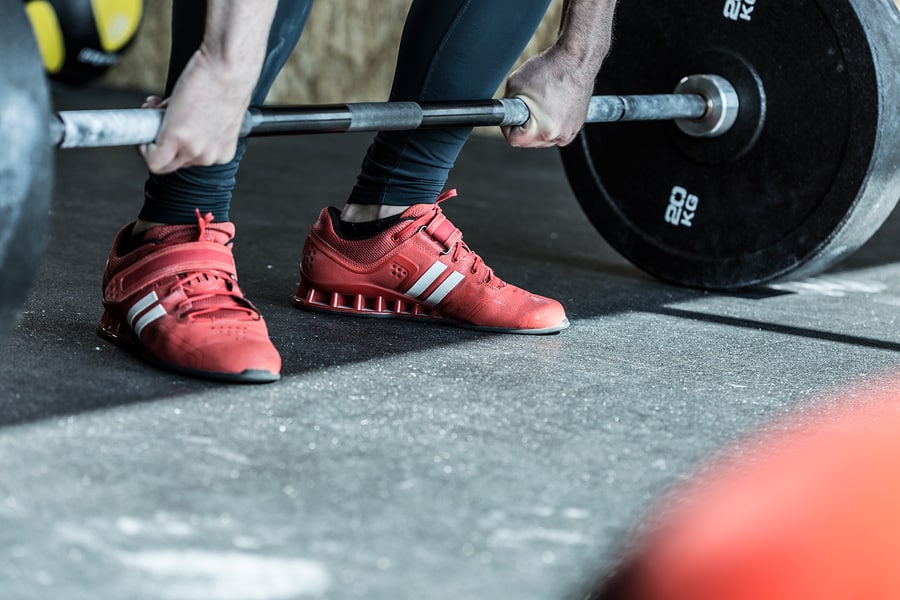
Weightlifting Shoes have a Midsole Strap
Weightlifting shoes also typically have some sort of in-step or midsole strap.
This helps ensure your foot is securely locked in place in the shoe.
The Nike Romaleos 4 has TWO straps – so you can dial in the fit to perfection.
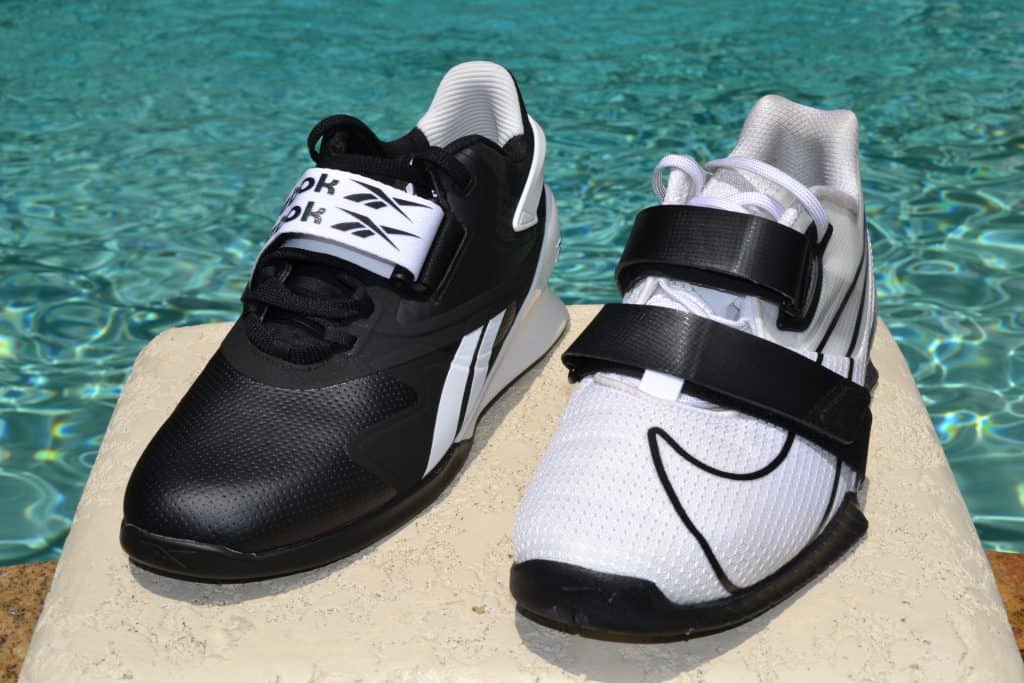
The Reebok Legacy Lifter II only has a single strap.
Both use a “hook and loop” (aka Velcro) strap that you can tighten as much or as little as you desire.
Again, this is to avoid all extraneous movement – which could cause injury otherwise.
Sliding and slipping also interferes with power transfer as you jerk or snatch a weight overhead.
Weightlifting Shoes Have a High-Traction, Grippy Sole
Lastly, weightlifting shoes usually have a high-traction outsole – for the maximum in grip and no slip.
A slipping foot while lifting weights could mean a nasty injury – so traction is of the utmost importance.
The downside to high traction rubber? It wears out quicker than harder rubber.
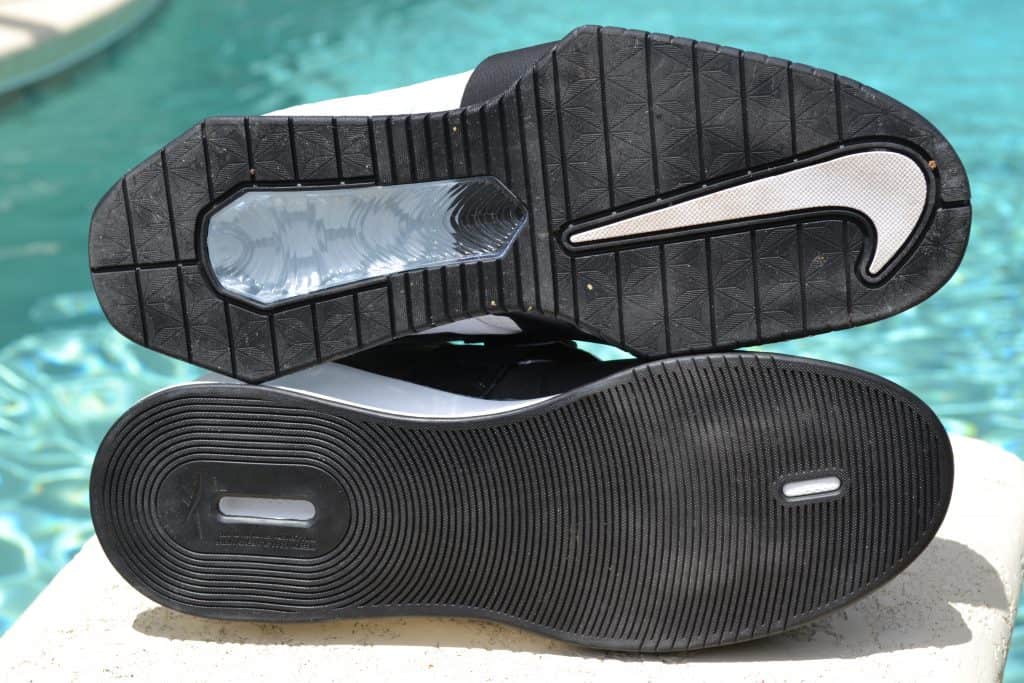
But that is OK, we’re not going to put a lot of “mileage” on our weightlifting shoes. You’re not going to wear these for a casual stroll around the neighborhood – or anywhere else.
Weightlifting Shoes are made for Olympic Weightlifting
With all these advantages – it’s a given that weightlifting shoes are essential gear for Olympic weightlifting.
Ever seen someone on the competition platform in running shoes?
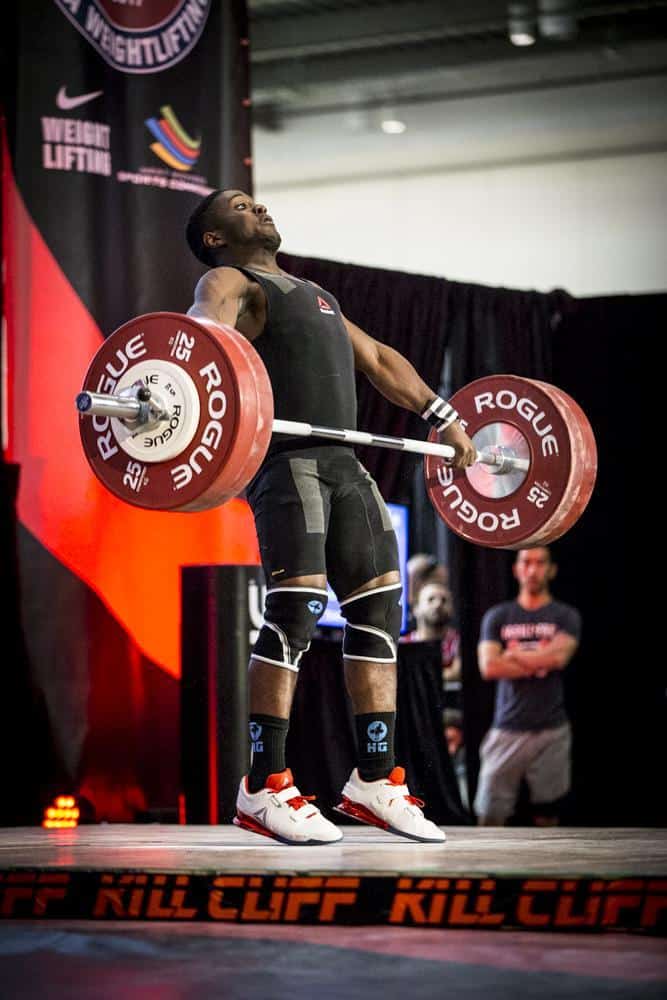
Take a look at some pictures of competitors – they’re all sporting raised heel, strapped in weightlifting shoes on the platform.
This is because there’s a huge amount of squatting in the Olympic lifts – because the bar always starts on the floor. Both the clean and jerk and the snatch are a lot easier with these shoes.
And of course we know that Olympic lifters do a lot of high bar, deep squatting to build strength in preparation for the competition movements.
Weightlifting shoes and the Oly lifts are a match made in heaven.
Weightlifting Shoes – Also Great for Powerlifting Squats
OK, so these are a required item for Oly lifting, but who else can benefit?
They are also great for heavy squats of any sort.
So whether you are practicing for the Oly lifts – or simply building strength with the high bar squat, low bar squat, or front squat variations – you can benefit from the solid, raised heel.
Much of the current revival of interest in squat shoes is thanks to Mark Rippetoe’s Starting Strength program – he’s a strong proponent of proper lifting shoes.
How about for deadlifting? Are there special deadlift shoes?
Having a stable sole is great for deadlifting, but this movement does not really require any ankle flexion – so the raised heel is of no benefit.
You will often see that many people prefer to deadlift in bare feet or flat-bottomed, solid heel shoes such as the iconic Chuck Taylors for precisely this reason.
This isn’t to say you can’t deadlift in weightlifting shoes – it’s just not an essential.
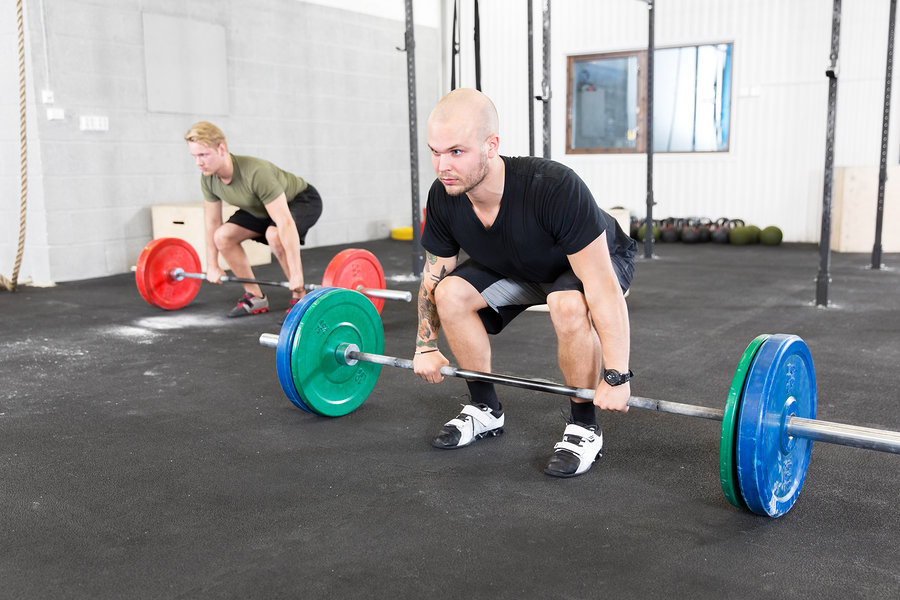
It’s also possible to develop better ankle flexibility – and range of motion. Squatting in flat sole shoes will help improve this and can eliminate some of the benefit of the raised heel. But you still need a solid heel, not a spongy one.
In powerlifting, the squat style often used emphasizes the use of the hamstrings more than the quads – and this tends to require a more verticle ankle. This means less ankle flexibility is needed – and therefore “lifters” become less of a benefit.
For example, take a look at a “box squat” – the ankle is almost fully upright.
Cons of Weightlifting Shoes
Ok, weightlifting shoes are great for lifting weights.
But, they aren’t good for much else.
It can’t all be rosy – after all, every design feature is a tradeoff.
Being built for rigidity and stability, they are heavy.
And that sky-high heel raise makes running (or jumping) in them an impossibility.
Not that you would want to anyways, the minimal cushioning means that would be a frightful experience.
They also aren’t as breathable as running shoes.
There’s no light-weight, mesh knit uppers in these shoes.
They wear out quicker – particularly in the sole where all that grippy, high-traction rubber is.
And lastly, they are pretty expensive, compared to main stream shoes.
But, again, they are still the best option for serious weightlifting.
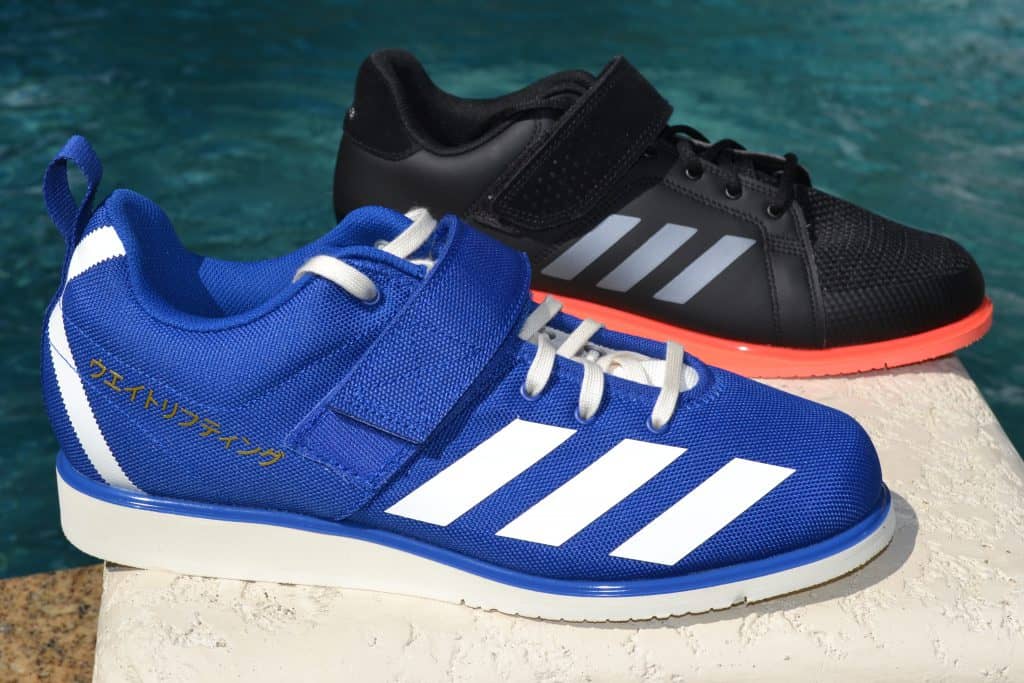
Best Shoes for Weightlifting in 2020
Now that we know what to look for – let’s look at the best weightlifting shoes for 2020. We’ll call out those special features we explained above.
Nike Weightlifting Shoes
Nike has only one weightlifting shoe for the year 2020, the Romaleos 4.
This is the fourth version of what is considered a classic weightlifting shoe.
(By the way, we did a full review of the Romaleos 4 earlier this year – if you really want to deep dive on the details.)
First, you can see the raised heel. It gives a 20mm offset – which is right where we’d expect it to be.
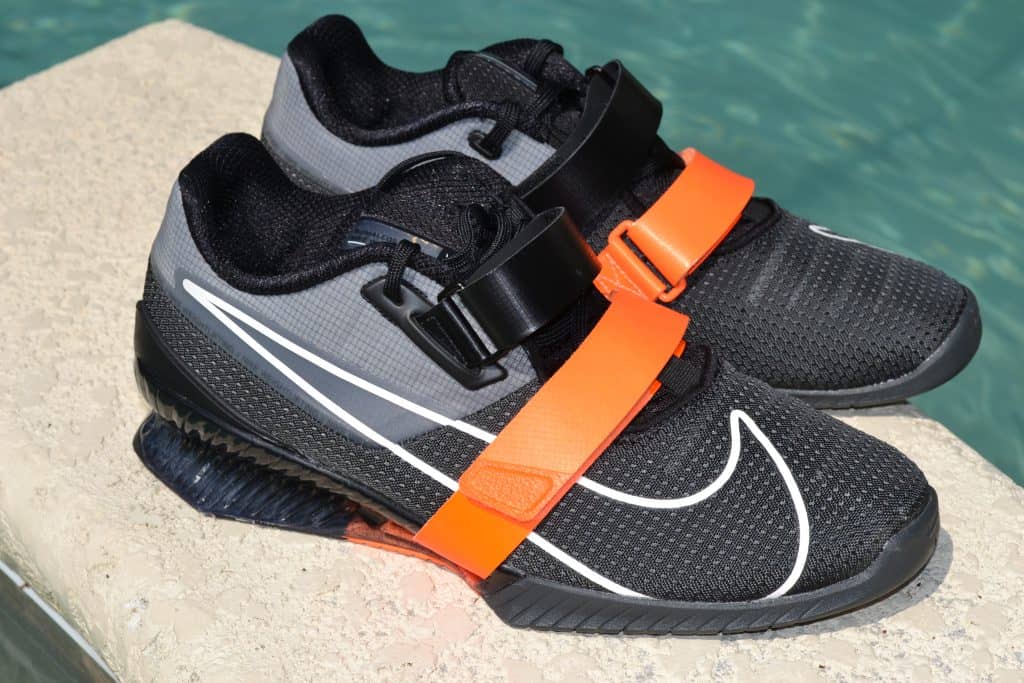
Is it rigid? Yep.
But, Nike has done things the smart way. The heel is built from a sophisticated polymer structure.
This gives a maximum of firmness and stability with a minimum of weight.
Weightlifting shoes are pretty heavy, when compared to normal shoes, and so we welcome the use of advanced materials to lighten these up.
A Men’s Size 11.5 weights about 22 ounces.
The dual midfoot straps are there for a locked in feel.
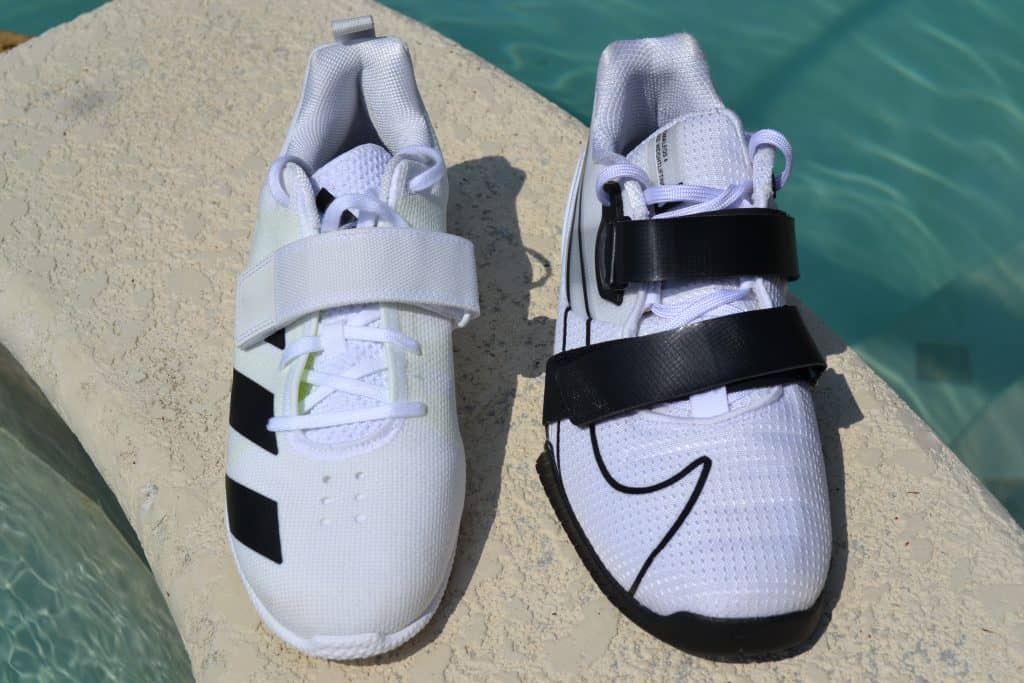
I like two straps versus one. It feels like you can dial things in more precisely compared to a shoe with a single strap.
(That said, it’s a small advantage at best.)
Prior versions of this shoe came with two interchangeable insoles for soft or firm support, but this year there’s only one – the “firm” option.
Overall this shoe hits the mark – it’s got the heel raise, it’s rock solid, but as an added benefit the lateral support is outstanding too.
The combination of the wide heel and the layers of material in the upper give you a “rooted to the floor” feeling. It is reassuring when you are under heavy weight.
Get a close-up look at the Romaleos 4 from our YouTube channel:
Here’s our biggest piece of advice if you buy the Romaleos 4 – Go 1/2 size up from your normal shoe size.
These are really narrow shoes. My regular shoe size (11) is just too tight in the toes.
By the way, last year’s model (the Nike Romaleos 3 XD) is an excellent shoe as well.
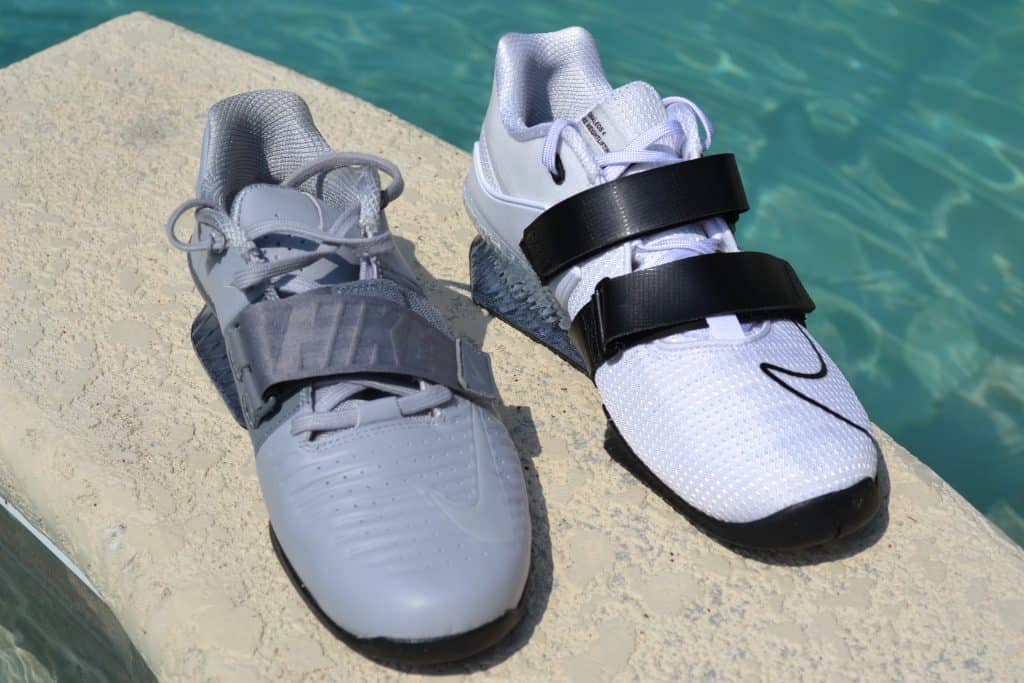
Quantities are limited and soon it will be hard to find your size.
But, these won’t last long.
So, if you want an outstanding weightlifting shoe on the cheap – grab a pair now.
Nike’s options are all high-end – because there is only one option.
Let’s look at what Adidas has to offer.
Adidas Weightlifting Shoes
Unlike Nike, Adidas has several weightlifting shoe options.
There are options across the board to fit any budget.
First, we’ll start with a legend – or the newest version of a legend.
The Adidas AdiPower II Weightlifting Shoe is the second version of a classic Adidas lifting shoe.
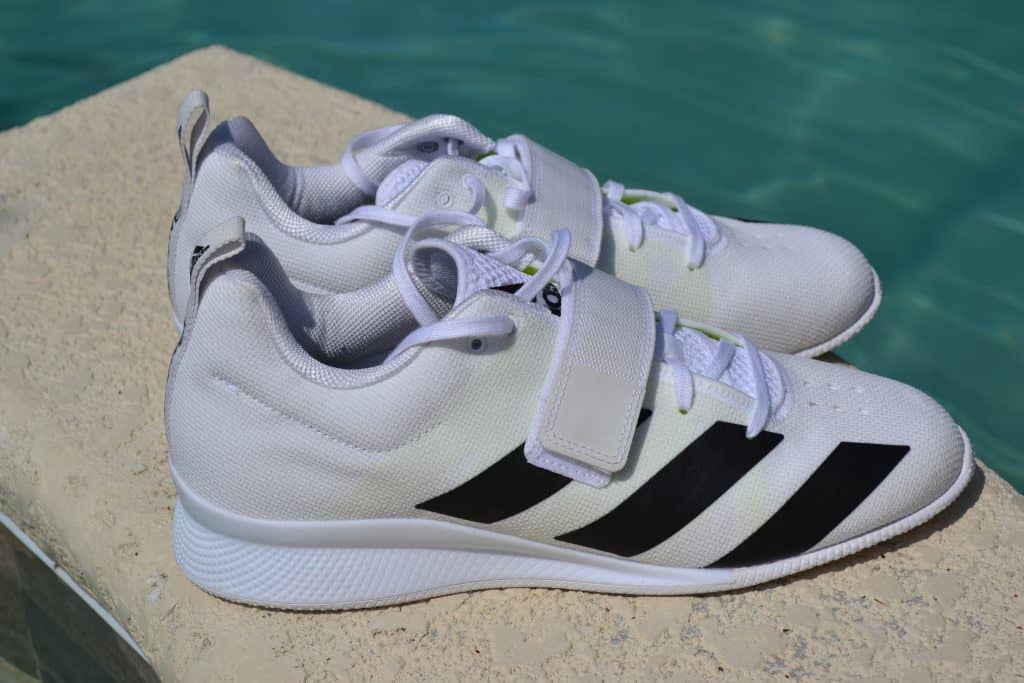
But, more importantly you can see the raised heel. Adidas claims the 20 mm heel to toe drop is optimal for Olympic lifting.
We can see a single mid-sole strap as well – to make sure the shoe fits perfect.
The woven upper also makes for a comfortable and breathable fit. It’s as comfortable as a running shoe!
This is the lightest and most flexible Oly lifter of our testing.
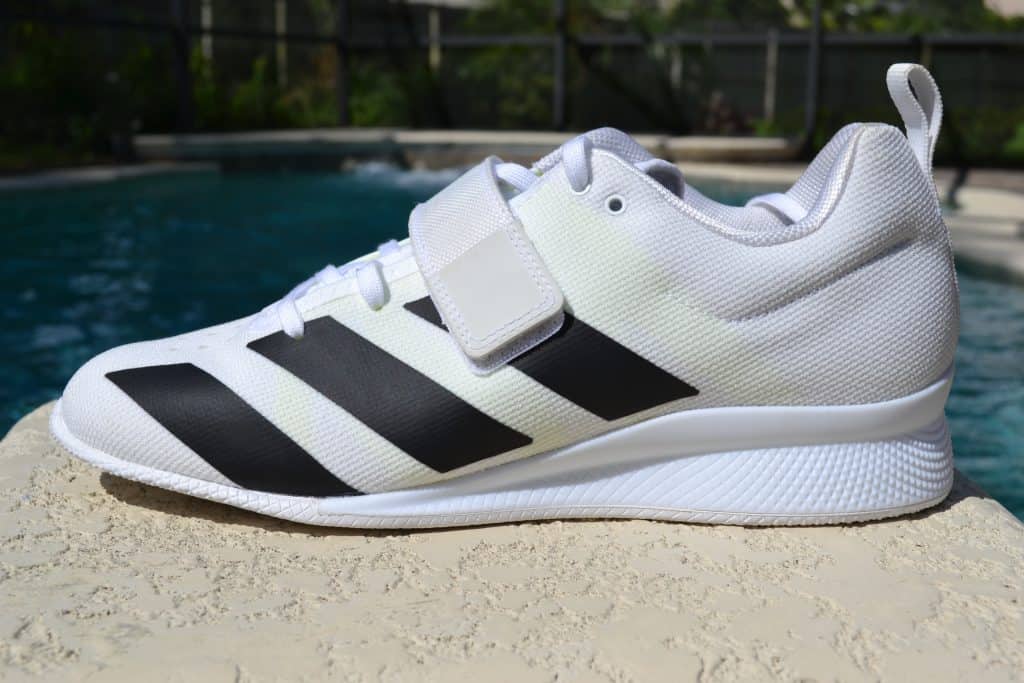
In fact, it’s really too flimsy and non-supportive – in my testing.
It lacks the feel of stability that one would typically get with a weightlifting shoe.
These also run super narrow – in fact the sizing is so far off, I’m not sure what to recommend to you.
But, if you really want a flexible, comfortable shoe with a heel raise – I suppose this is your best option.
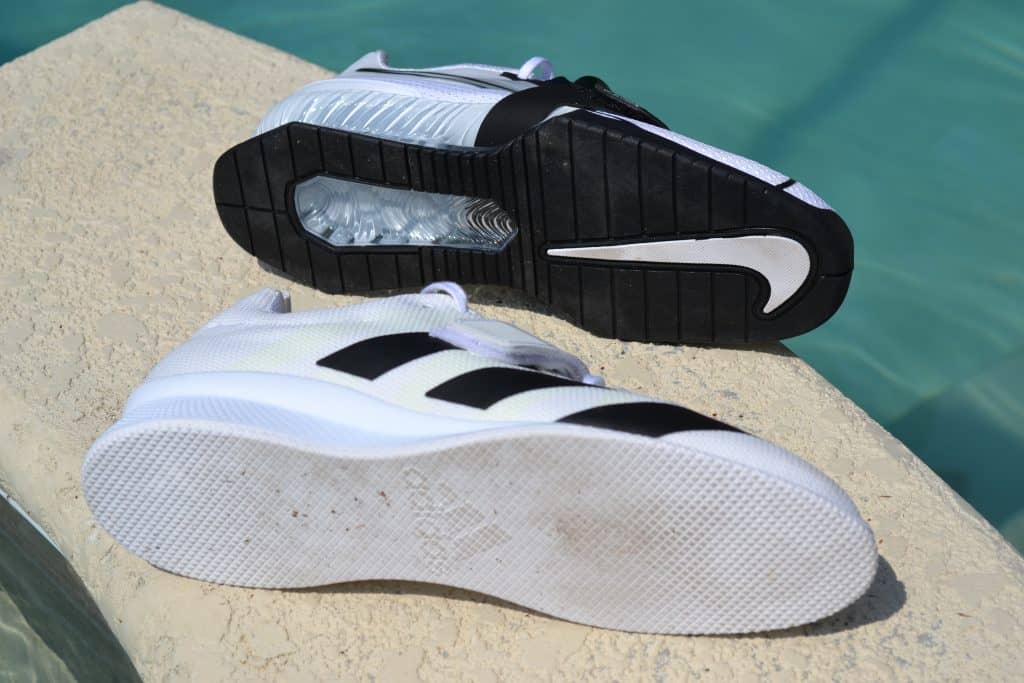
Here’s a side by side comparison with the Nike Romaleos 4:
So, the Adipower II is a very unique shoe. Is it right for you? Maybe, but just heed our cautions.
Let’s move on and look at budget-friendly options, if you are looking for a budget weightlifting shoe option.
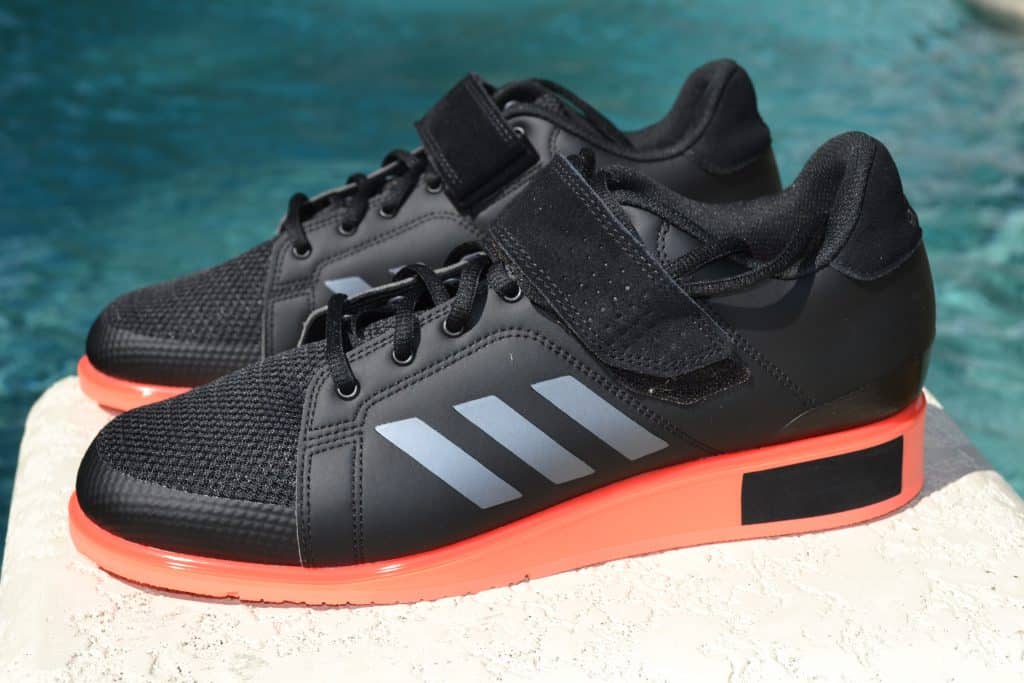
The Adidas Power Perfect 3 is a budget-friendly weightlifting shoe from Adidas.
A quick glance shows just what you’d expect from a weightlifting shoe: a high raised heel and a hook-and-loop (aka Velcro) instep strap.
The synthetic upper looks and feels cheap – but it gives you great support.
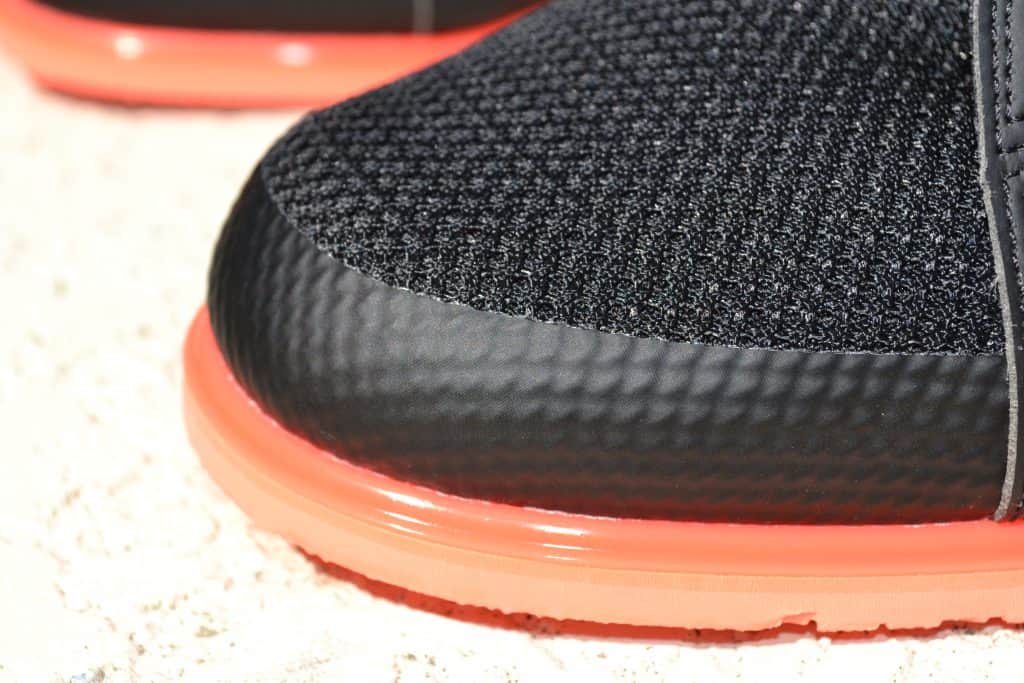
It’s also got an integral heel support for additional stability.
What’s the drop? 19 mm.
And you can’t see the die cut wedge midsole, which is high density and offers plenty of support
We compared this shoe side by side with the Powerlift 4 :
The Power Perfect 3 actually runs true to size – so order your normal size.
Let’s look at the next weightlifting shoe from Adidas.
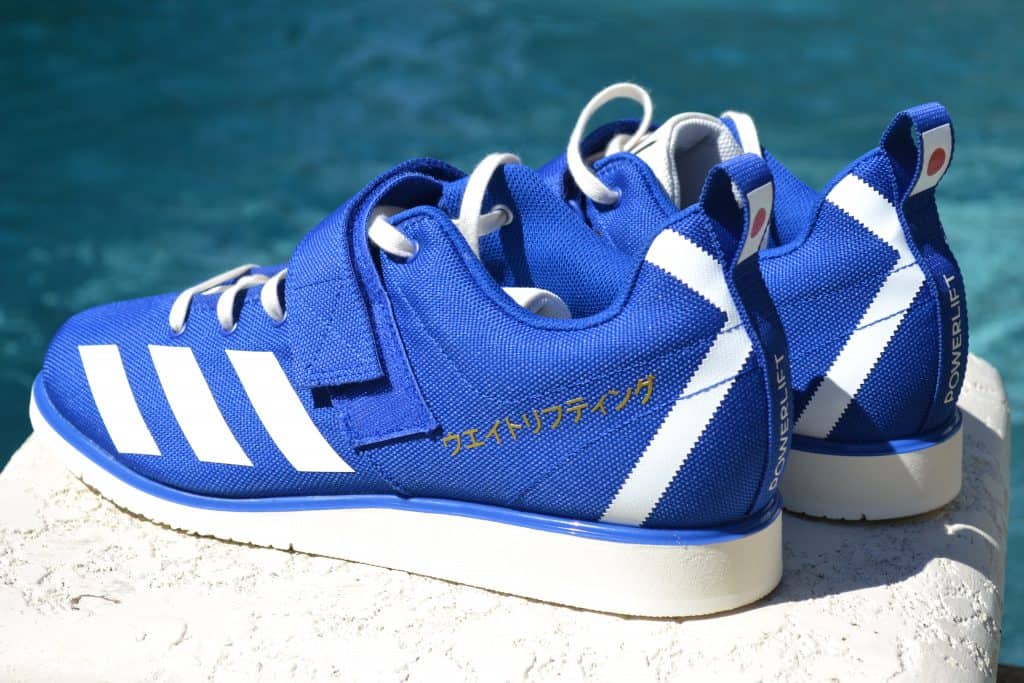
The upper is canvas. It’s comfortable and looks good. But, it doesn’t offer as much support as the upper of the Power Perfect 3.
Otherwise, we see what you’d expect to see – raised heel, instep strap, etc.
This shoe gives you a 15mm heel raise. Not bad, but pretty far off from some of these other shoes.
This particular shoe does run true to size, but it is a narrower design than the Power Perfect 3 – you might need to go 1/2 size up if you have narrow feet.
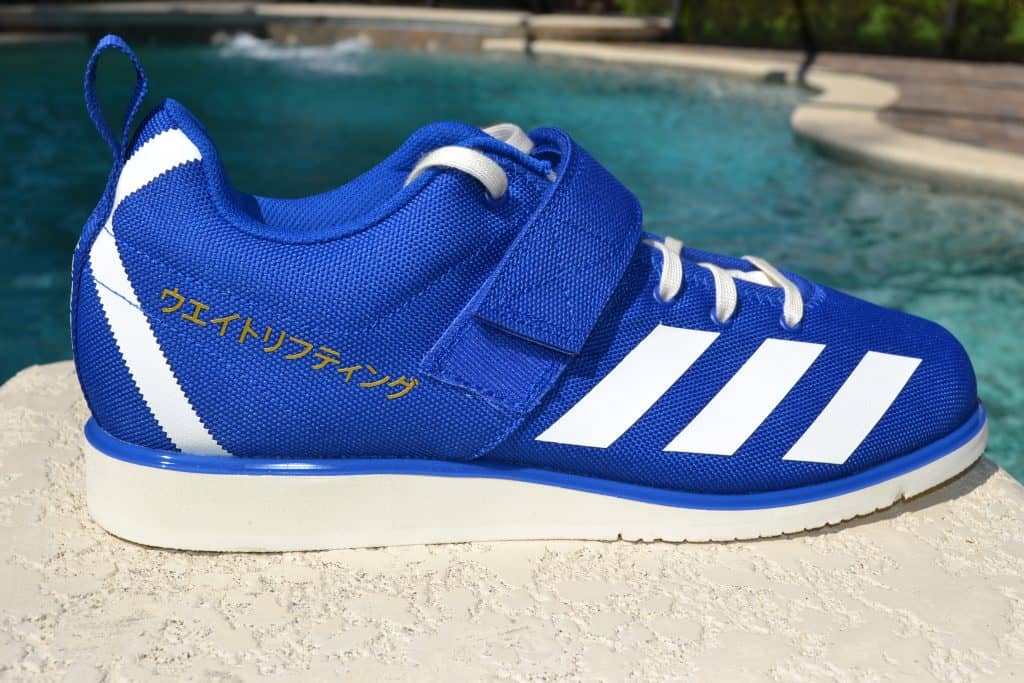
By the way, deep dive on the Power Perfect 3 versus Powerlift 4 in our in-depth review. There’s a lot of side by side comparison photos in that article.
Let’s look at options from Reebok.
Reebok Weightlifting Shoes
Reebok offers the Legacy Lifter II shoe for 2020. This is the 2nd version of the shoe – and it’s really, really good.
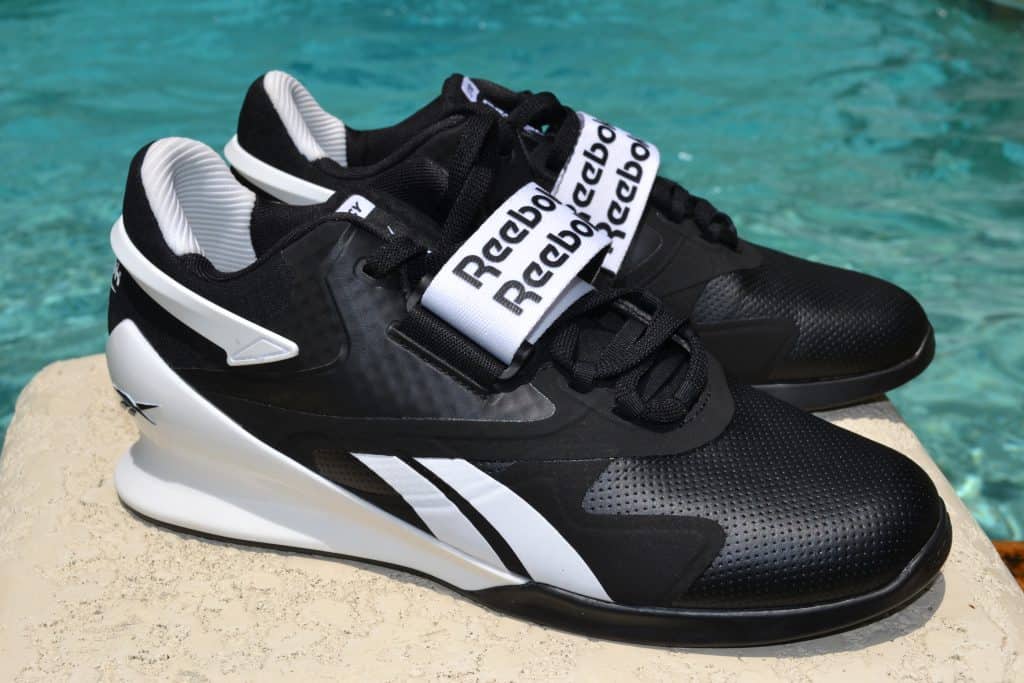
Why?
22 mm heel raise and rock solid support in the heel, forefoot, and laterally.
It’s a heaviest shoe here – a Men’s Size 11 weights over 23 ounces.

This year, Reebok has gone with one velcro strap instead of two.
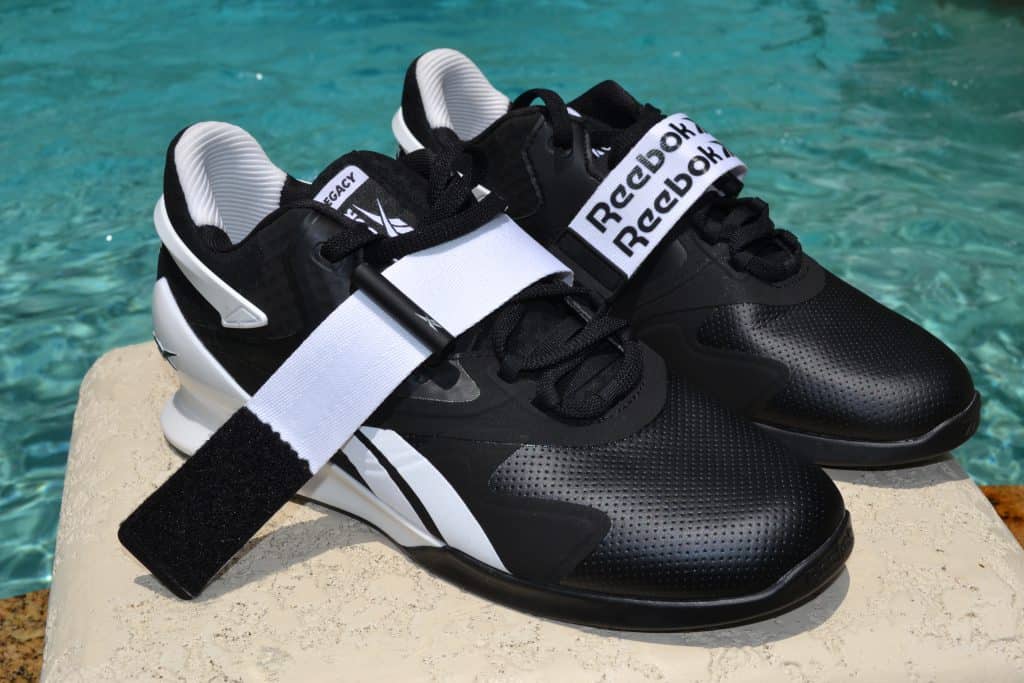
This shoe is quieter than the Romaleos 4 – it isn’t as noisy when you are walking around in it – or lifting.
The more conservative styling is a plus too – many don’t like the wild looks of the Rom 4.
Whether you prefer the Nike Romaleos 4 or the Reebok Legacy Lifter II, you can’t go wrong – both are excellent.
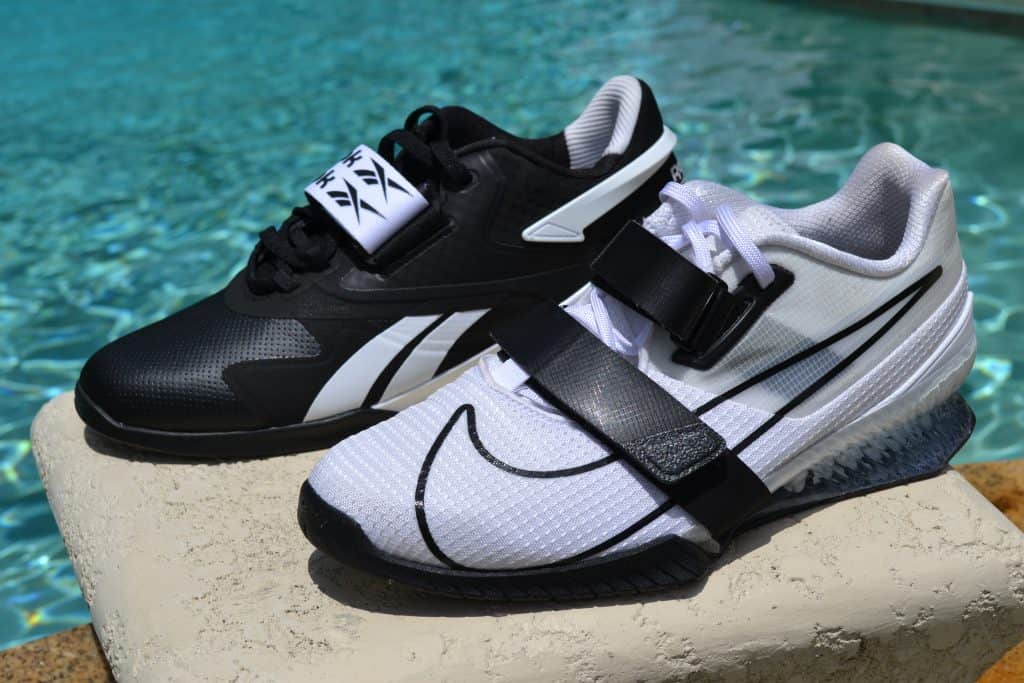
We took a hands-on look at this shoe earlier this year:
We also did an intensive review of this shoe (photos, comparisons, and more): Reebok Legacy Lifter II Review.
By the way, you can still find the Legacy Lifter (original) – that’s a great shoe too.
Gym Backpack for Weightlifting Shoes
Ok, we’ve looked at some great weightlifting shoe options.
But, as we mentioned they are really specialized and you don’t want to wear them out.
Nor are they comfortable for every day wear.
We recommend you pack them in the gym bag and put them on when you need to lift, and then back off again.
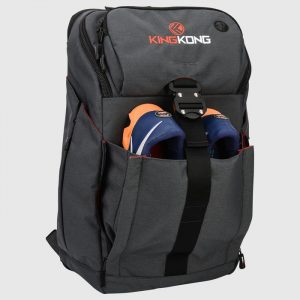
The Backpack II from King Kong apparel is the perfect solution.
First, this is one tough backpack – made from Mil Spec 1000D Nylon.
But, what we like most are the dedicated shoe compartments.
These are intelligently designed to help preserve valuable internal space.
These external compartments also help ensure the shoes dry out after use.
Available in a variety of colors, this is a great gym backpack or gym bag solution.
This is the best way to transport your weightlifting shoes to and from the gym or box – and keep the “mileage” off these specialized shoes.
The other thing we LOVE about this bag – it’s a lay flat packing bag.
Stop trying to jam your weightlifting gear into a laptop bag – a duffel style, flat packing bag is a better choice.
And by the way, you can still pack a laptop in it, if you need to.
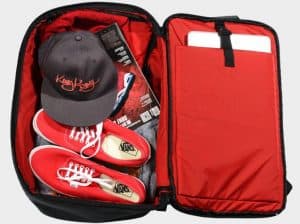
Ok, let’s get back to the shoes.
Do-Win Classic Lifter – Weightlifting Shoes 2020
We’ve got one more option for you. It’s a brand you might not have ever heard about, but they make an excellent, no-frills weightlifting shoe.
And unlike all the other shoes here, they are made with actual leather (suede).
The Do-Win Classic Lifter, shown here in black, is a great weightlifting shoe.
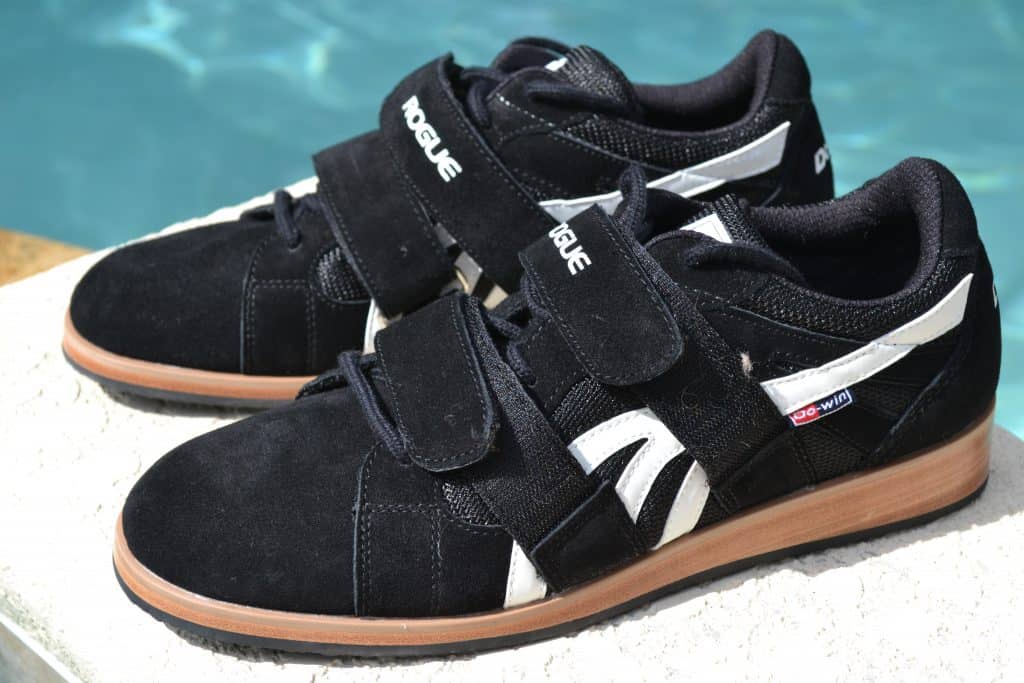
Heel to toe drop is .75″ (19mm).
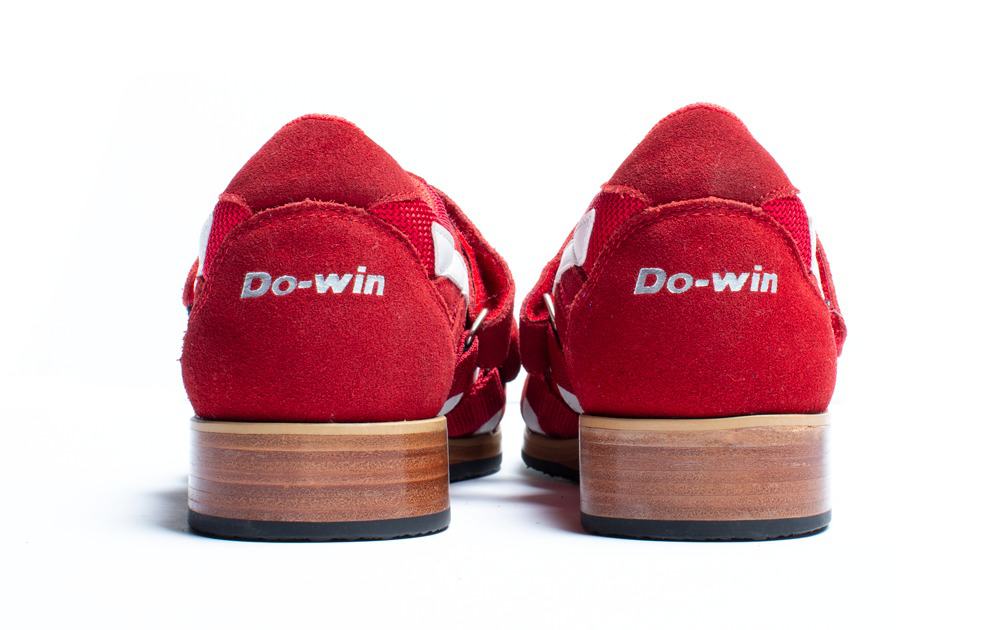
This “classic” show eschews modern composite material for the heel – it’s crafted from layers of stacked leather.
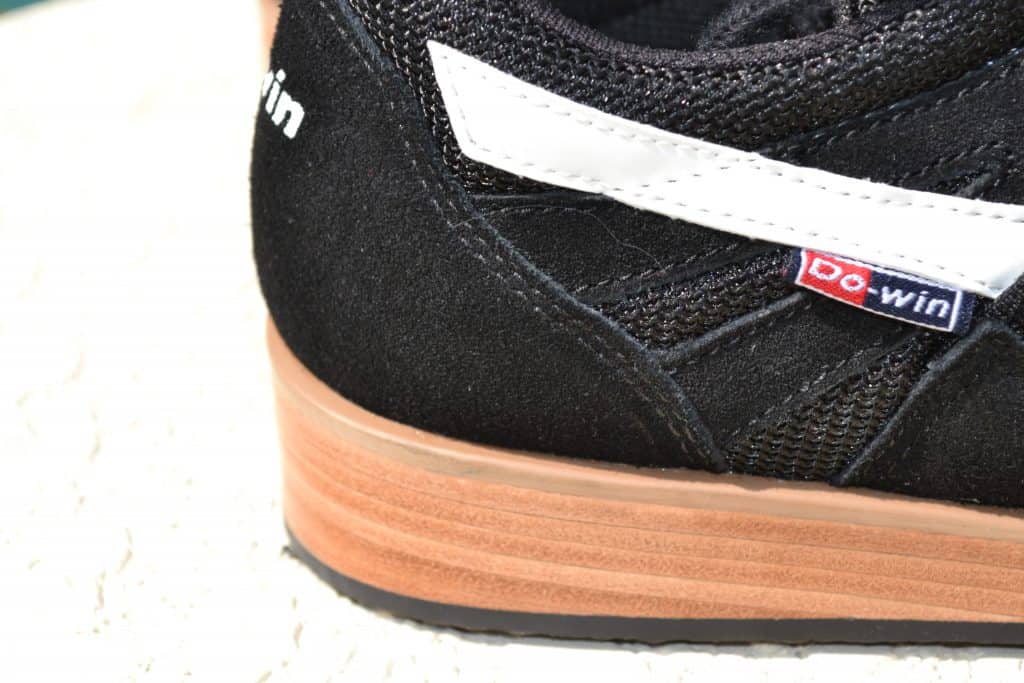
And it looks great.
Midfoot strap with hook and loop (“velcro”) closure is in place.
And we have a super grippy sole as well.
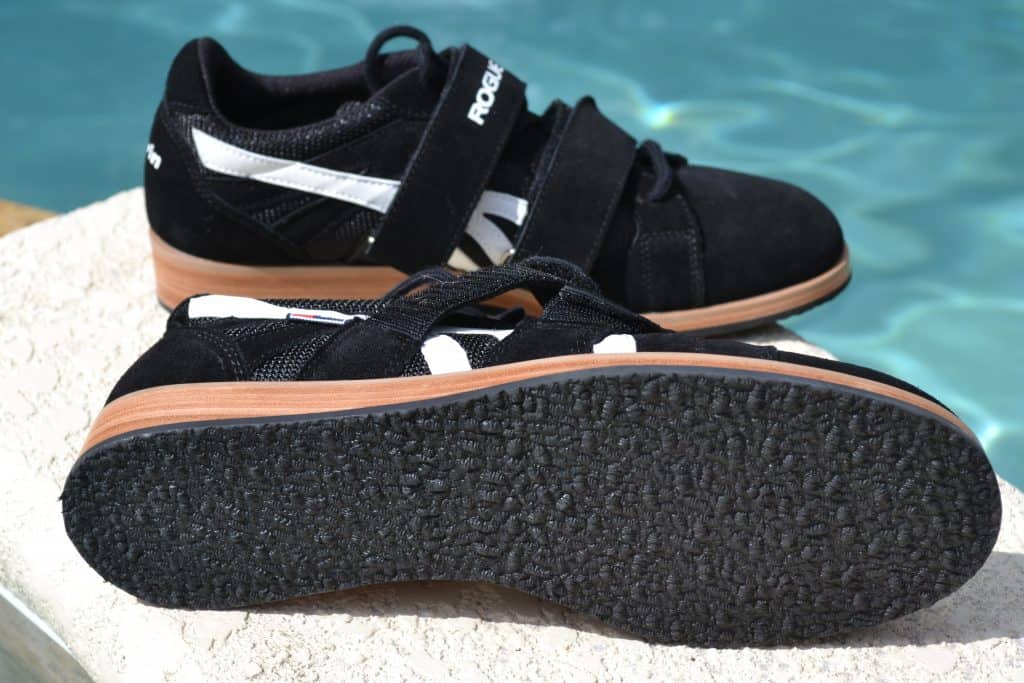
The Do-Win Classic Lifter is available in red, blue, or black.
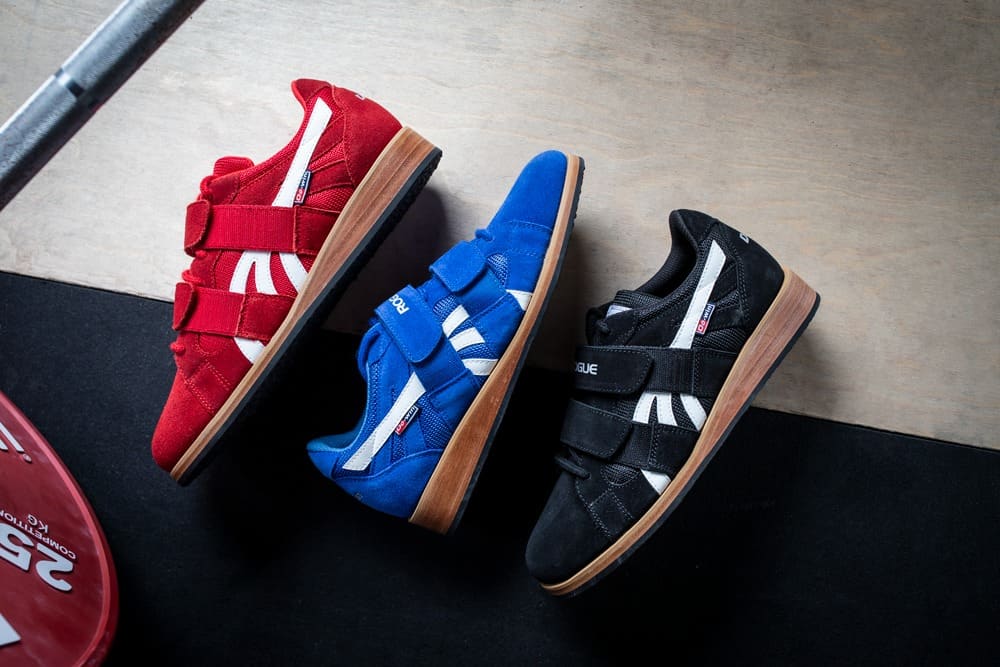
Do-wins were the first pair of lifters I ever owned – 10 years ago.
These newer versions have what you need – at a great price.
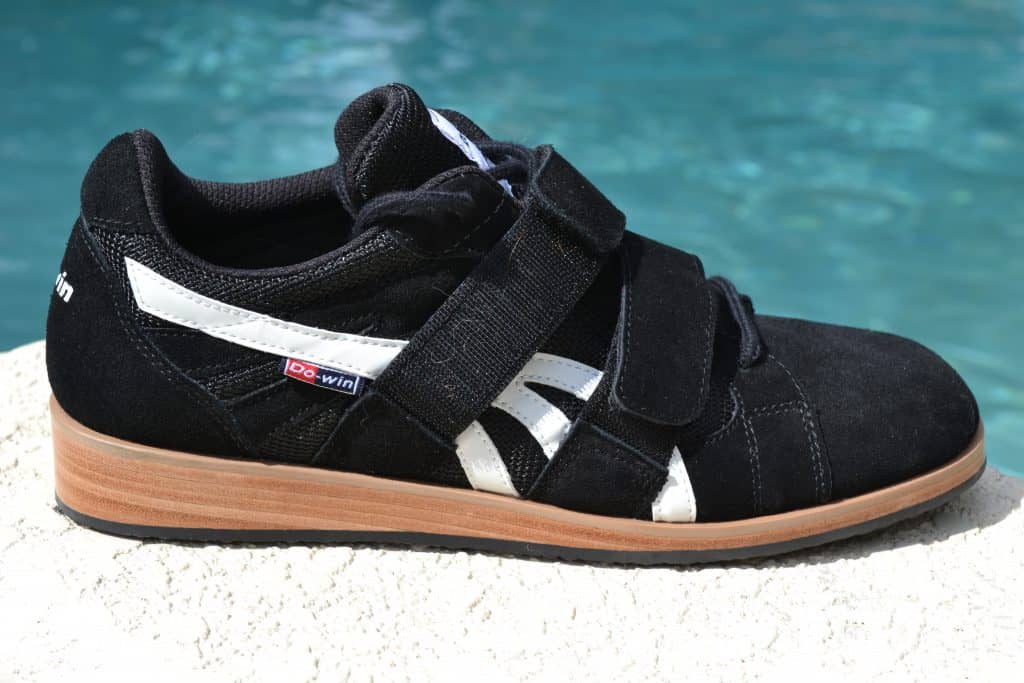
And guess what? I made a video about these too:
Can’t get enough of this awesome leather weightlifting shoe? Check out our full Do-Win Classic Lifter Review – there’s even more photos and commentary!.
In Summary – Best Weightlifting Shoes for 2022
If you are doing serious Olympic weightlifting training a proper pair of weightlifting shoes is essential.
Adidas, Nike, and Reebok all offer shoes with the features we need – solid, rigid sole, raised heel, and midsole straps.
We consider the Nike Romaleos 4 and Reebok Legacy Lifter II to be the best weightlifting shoes available in 2022.
The Nike shoe has bold styling – and it’s noisier – but it delivers where it matters in a weightlifting shoe.
But, the Legacy Lifter II is also a great choice – but more conservative-looking and quieter.
Grab a pair of Rogue weightlifting shoes today and see your technique and lifts improve.
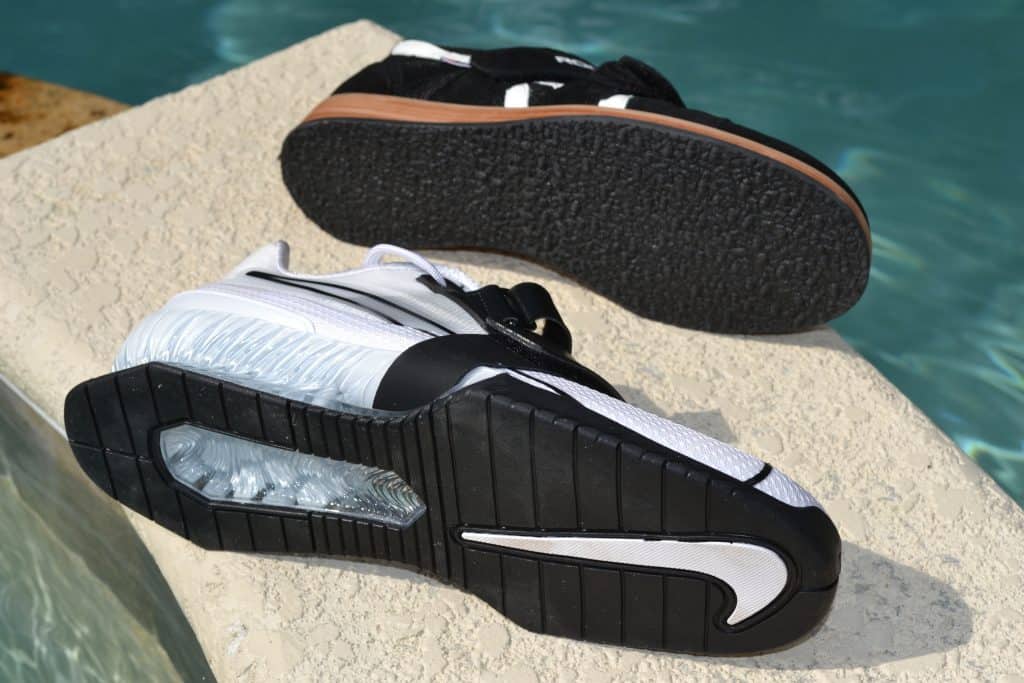
Photo and Image Credits
- Some additional product photos are courtesy of Reebok, Adidas, and Nike.
- Some product imagery on this page is property of Rogue Fitness and provided by Rogue Fitness.
- We are an affiliate of Rogue Fitness and King Kong Apparel. If you purchase Rogue weightlifting shoes or other gear through the links in this article, we receive a small commission fee at no additional cost to you.
- This website is not affiliated or associated with CrossFit, Inc. CrossFit is a registered trademark of CrossFit, Inc.
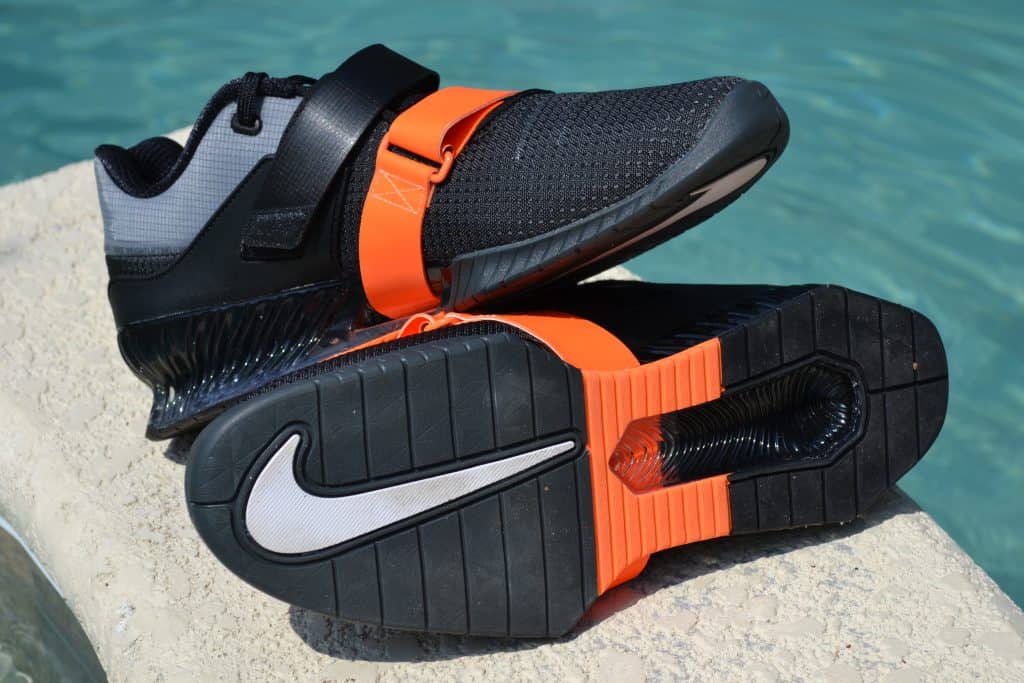

Tim is the founder of FitAtMidlife.com – an avid gym rat for 30+ years, he’s a reviewer of many, many shoes – and founder of the Speed Bag Gathering – the world’s only gathering of speed bag punching enthusiasts. See more gym reviews at Tim’s YouTube channel.

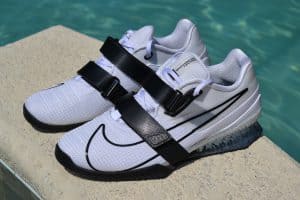
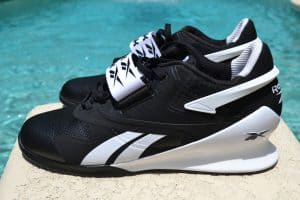
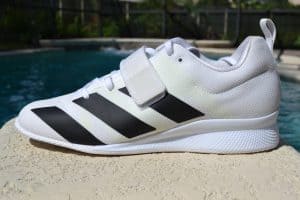
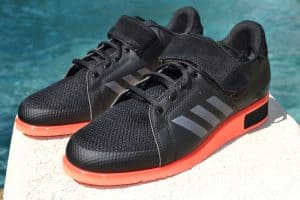
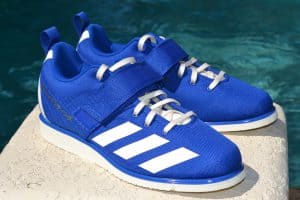
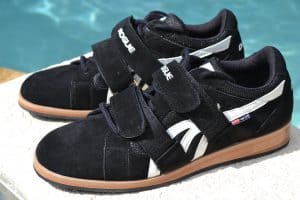
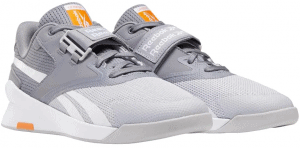
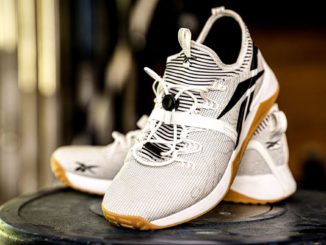
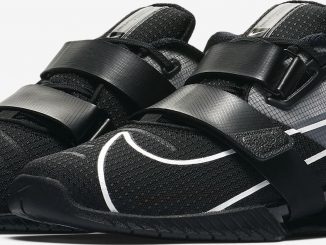
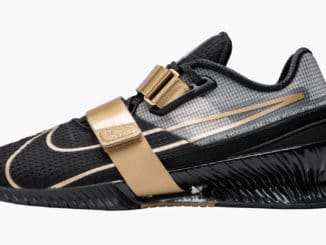
Back in stock – finally!
Rogue is currently out of stock – but they are expecting to get more in stock around the beginning of May.
They had them in stock as of about 1 week ago – They possibly have sold out, as it is definitely no longer listed on their web site. I will ask them.
Hello!
When did you see the Do-Win Classic lifter shoe online? Rogue evidently isnt selling them right now? How did you come across this shoe?
Ive been looking for a new pair like this forever!